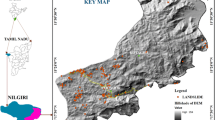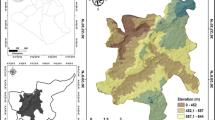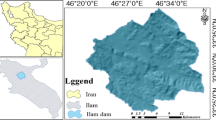Abstract
This paper presents the application of geographic information system (GIS)-based fuzzy logic to infer landslide susceptibility for a preliminary mapping of Vitória, Espírito Santo, Brazil. Input spatial layers derived from a digital elevation model, roads, land-use, and geotechnical type were classified, and previous geological accident occurrences were summarized for each class. The fuzzy membership functions and fuzzy rules were extracted by determining the landslide frequency ratio for each class of conditioning factors of elevation, slope, profile and plan curvature, aspect, distance to drainage lines, and distance to roads. The analytic hierarchy process was applied to rank classes of land-use and geotechnical type based on expert knowledge. The spatial layers were combined by fuzzy overlay procedures in a GIS and results were compared with a weighted mean method. The results from the fuzzy and weighted mean methods were also compared with previous geological–geotechnical risk maps, providing statistics to assess the best options from different viewpoints. One advantage of this method is that it enables spatial data layers with discrete and continuous data to be used as input in a fuzzy inference system, taking into account both knowledge of previous events and expert knowledge.








Similar content being viewed by others
References
Aksoy B, Ercanoglu M (2012) Landslide identification and classification by object-based image analysis and fuzzy logic: an example from the Azdavay region (Kastamonu, Turkey). Comput Geosci 38(1):87–98
Akgun A, Dag S, Bulut F (2008) Landslide susceptibility mapping for a landslide-prone area (Findikli, NE of Turkey) by likelihood frequency ratio and weighted linear combination models. Environ Geol 54:1127–1143
Bortoloti FD (2012) Redes neurais com topologias otimizadas aplicadas na modelagem de dados geotécnicos e pluviométricos para predição de deslizamentos de solo. Mestrado, Universidade Federal do Espírito Santo, Vitória
Brasil, Ministério das Cidades (2006) Treinamentos de técnicos municipais para o mapeamento e gerenciamento de áreas urbanas com risco de escorregamentos, de enchente e de áreas contaminadas. In: Programa de Prevenção e Erradicação de Riscos, Secretaria de Programas Urbanos. disponível no site. http://www.cidades.gov.br, acessado em junho de 2006
Castro Junior RM, Bortoloti FD, Glória KS, Lopes LCFL, Saquetto Junior A (2011) Aplicação das ferramentas ArcGIS e Rockworks como apoio a geração de elementos para elaboração da carta geotécnica do município de Vitória-ES. In: \(13^{o}\) Congresso de Geologia de Engenharia e Ambiental, São Paulo, SP. ABGE
Cervi F, Berti M, Borgatti L, Ronchetti F, Manenti F, Corsini A (2010) Comparing predictive capability of statistical and deterministic methods for landslide susceptibility mapping: a case study in the northern Apennines (Reggio Emilia Province, Italy). Landslides 8:12
Ercanoglu M, Temiz FA (2011) Application of logistic regression and fuzzy operators to landslide susceptibility assessment in Azdavay (Kastamonu, Turkey). Environ Earth Sci 64(4):949–964
Hasekioğulları GD, Ercanoglu M (2012) A new approach to use AHP in landslide susceptibility mapping: a case study at Yenice (Karabuk, NW Turkey). Nat Hazards 63(2):1157–1179
Instituto de Pesquisa Tecnológica (IPT) (1980) Instabilidade da Serra do Mar no Estado de São Paulo, Situações de Risco, Ações Necessárias Secretaria de Ciência e Tecnologia-Secretaria do Meio Ambiente, vol I
Intarawichian N, Dasananda S (2011) Frequency ratio model based landslide susceptibility mapping in lower Mae Chaem watershed, Northern Thailand. Environ Earth Sci 64(2271–2285):2011
Kannan M, Saranathan E, Anabalagan R (2013) Landslide vulnerability mapping using frequency ratio model: a geospatial approach in Bodi-Bodimettu Ghat section, Theni district, Tamil Nadu, India. Arab J Geosci 6(2901–2913):2013
Kanungo DP, Arora MK, Sarkar S, Gupta RP (2009) Landslide susceptibility zonation (LSZ) mapping—a review. J South Asia Disaster Stud 2(1):81–106
Kayastha P, Dhital M, De Smedt F (2013) Application of the analytical hierarchy process (AHP) for landslide susceptibility mapping: a case study from the Tinau watershed, west Nepal. Comput Geosci 52:398–408
Kohavi R, Provost F (1998) Glossary of terms. Spec Issue Appl Mach Learn Knowl Discov Process 30:271–274
Lee S (2006) Application and verification of fuzzy algebraic operators to landslide susceptibility mapping. Environ Geol 52(4):615–623
Mamdani EH (1974) Application of fuzzy algorithms for control of simple dynamic plant. Proc Inst Electr Eng 121(12):1585–1588
Mamdani EH, Assilian S (1999) An Experiment in Linguistic Synthesis with a Fuzzy Logic Controller. Int J Hum–Comput Stud 51(2):135–147
Moghaddam R (2013) Landslide susceptibility mapping for the Urmia Lake basin, Iran: a multi-criteria evaluation approach using GIS. Int J Environ 7(2):319–336
Mondal S, Maiti R (2014) Integrating the analytical hierarchy process (AHP) and the frequency ratio (FR) model in landslide susceptibility mapping of Shiv-khola watershed, Darjeeling Himalaya. Int J Disaster Risk Sci 4(4):200–212
Moradi M, Bazyar MH, Mohammadi Z (2012) GIS-based landslide susceptibility mapping by AHP method, a case study, Dena City, Iran. J Basic Appl Sci Res 2(7):6715–6723
Oh H-J, Pradhan B (2011) Application of a neuro-fuzzy model to landslide susceptibility mapping for shallow landslides in a tropical hilly area. Comput Geosci 37(9):1264–1276
Pourghasemi HR, Mohammady M, Pradhan B (2012a) Landslide susceptibility mapping using index of entropy and conditional probability models in GIS: Safarood Basin, Iran. CATENA 97:71–84
Pourghasemi HR, Pradhan B, Gokceoglu C (2012b) Application of fuzzy logic and analytical hierarchy process (AHP) to landslide susceptibility mapping at Haraz watershed, Iran. Nat Hazards 63(2):965–996
Pourghasemi HR, Moradi HR, Fatemi Aghda SM, Gokceoglu C, Pradhan B (2014) GIS-based landslide susceptibility mapping with probabilistic likelihood ratio and spatial multi-criteria evaluation models (North of Tehran, Iran). Arab J Geosci 7(5):1857–1878
Powers D (2011) Evaluation: from precision, recall and \(F\)-measure to ROC, informedness, markedness and correlation. J Mach Learn Technol 2:37–63
Pradhan B, Lee S, Buchroithner MF (2009) Use of geospatial data and fuzzy algebraic operators to landslide-hazard mapping. Appl Geomat 1(1–2):3–15
Pradhan B (2010a) Landslide susceptibility mapping of a catchment area using frequency ratio, fuzzy logic and multivariate logistic regression approaches. J Indian Soc Remote Sens 38:301–320
Pradhan B (2010b) Manifestation of an advanced fuzzy logic model coupled with geo-information techniques to landslide susceptibility mapping and their comparison with logistic regression modelling. Environ Ecol Stat 18(3):471–493
Pradhan B (2010c) Use of GIS-based fuzzy logic relations and its cross application to produce landslide susceptibility maps in three test areas in Malaysia. Environ Ecol Stat 63(2):329–349
Regmi NR, Giardino JR, Vitek JD (2010) Assessing susceptibility to landslides: using models to understand observed changes in slopes. Geomorphology 122(1–2):25–38
Regmi AD, Yoshida K, Pourghasemi HR, Dhital MR (2014) Landslide susceptibility mapping along Bhalubang-Shiwapur area of mid-Western Nepal using frequency ratio and conditional probability models. J Mt Sci 11:1266–1285
Saaty T (1977) A scaling method for priorities in hierarchical structures. J Math Psychol 15:234–281
Shahabi H, Khezri S, Ahmad BB, Allahvirdiasl H (2012) Application of satellite images and fuzzy set theory in landslide hazard mapping in Central Zab basin. J Appl Phys 1(4):17–24
Shahabi H, Hashim M, Bin B (2015) Remote sensing and GIS-based landslide susceptibility mapping using frequency ratio, logistic regression, and fuzzy logic methods at the Central Zab basin. Iran. Earth Environ Sci
Solaimani K, Mousavi Seyedeh Zohreh, Kavian Ataollah (2013) Landslide susceptibility mapping based on frequency ratio and logistic regression models. Arab J Geosci 6(7):2557–2569
Sujatha ER, Rajamanickam V (2011) Landslide susceptibility mapping of Tevankarai Ar sub-watershed, Kodaikkanal taluk, India, using weighted similar choice fuzzy model. Nat Hazards 59(1):401–425
Tien Bui D, Pradhan B, Lofman O, Revhaug I, Dick OB (2012) Landslide susceptibility mapping at Hoa Binh province (Vietnam) using an adaptive neuro-fuzzy inference system and GIS. Comput Geosci 45:199–211
Valeriano MM, Carvalho Júnior OA (2003) Geoprocessamento de Modelos Digitais de Elevação para Mapeamento da Curvatura horizontal em Microbacias geoprocessing of digital elevation models for mapping plan curvature in watersheds. Revi Bras de Geomorfol Ano 4(1):17–29
Yalcin A (2008) GIS-based landslide susceptibility mapping using analytical hierarchy process and bivariate statistics in Ardesen (Turkey): comparisons of results and confirmations. CATENA 72(1):1–12
Youssef AM, Al-Kathery M, Pradhan B (2015) Landslide susceptibility mapping at Al-Hasher area, Jizan (Saudi Arabia) using GIS-based frequency ratio and index of entropy models. Geosci J 19(1):113–134
Youssef AM (2015) Landslide susceptibility delineation in the Ar-Rayth area, Jizan, Kingdom of Saudi Arabia, using analytical hierarchy process, frequency ratio, and logistic regression models. Earth Environ Sci
Zadeh L (1965) Fuzzy sets. Inf Control 8:338–352
Author information
Authors and Affiliations
Corresponding author
Rights and permissions
About this article
Cite this article
Bortoloti, F.D., Castro Junior, R.M., Araújo, L.C. et al. Preliminary landslide susceptibility zonation using GIS-based fuzzy logic in Vitória, Brazil. Environ Earth Sci 74, 2125–2141 (2015). https://doi.org/10.1007/s12665-015-4200-6
Received:
Accepted:
Published:
Issue Date:
DOI: https://doi.org/10.1007/s12665-015-4200-6




